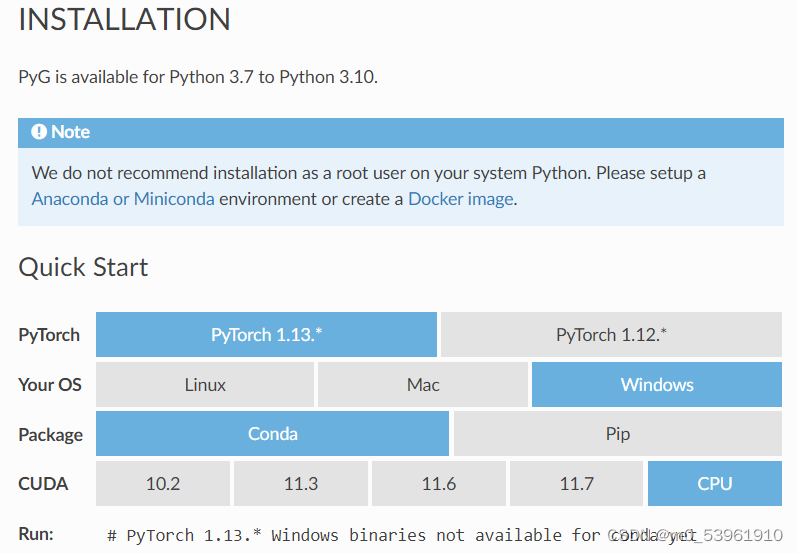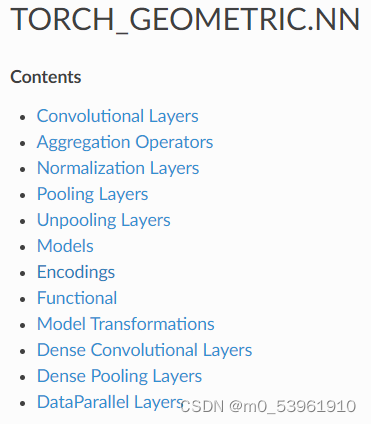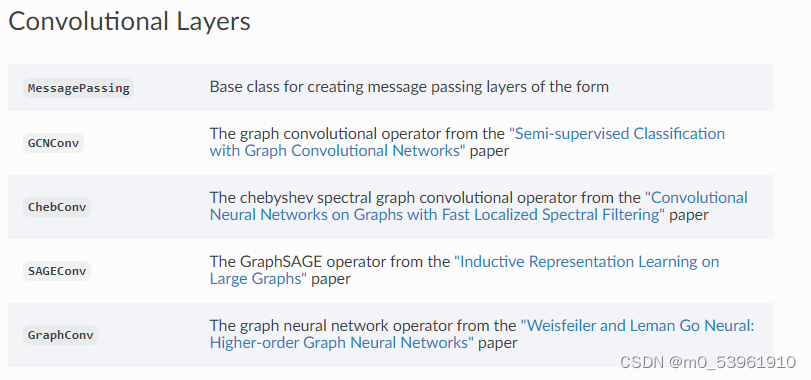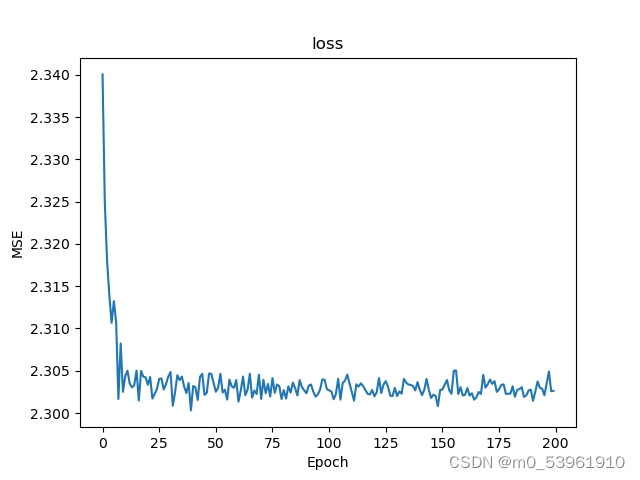最近论文中需要使用图卷积神经网络(GNN),看了一些关于GCN的代码,还有基于PyTorch Geometric Temporal的代码实现,在这里做一下记录。
GCN原始代码
关于GCN的原理在这里不进行过多阐述,其他文章里面解释的已经很详细了,这里就直接进入到代码的部分。GCN的公式如下:
其中*为邻接矩阵;
为t时刻输入的节点的特征矩阵;
是近似的图卷积滤波器,其中**
****=
+
(
是N维的单位矩阵);
是度矩阵;
代表需要神经网络训练的权重矩阵;
是激活函数Relu。*
根据公式逐步实现GCN的代码如下:
def get_gcn_fact(adj):
'''
Function to calculate the GCN factor of a certain network snapshot
计算GCN因子(图卷积因子D^-1/2AD^-1/2)的函数
:param adj: the adjacency matrix of a specific network snapshot 特定网络快照的邻接矩阵
:return: the corresponding GCN factor 对应的GCN因子 DAD
'''
adj_ = adj + np.eye(node_num, node_num) # A+IN
row_sum = np.array(adj_.sum(1)) # 求度矩阵D
d_inv_sqrt = np.power(row_sum, -0.5).flatten() # D^-1/2
d_inv_sqrt[np.isinf(d_inv_sqrt)] = 0. # 将一些计算得到的NAN值赋0值
d_mat_inv_sqrt = np.mat(np.diag(d_inv_sqrt)) # 将D^-1/2对角化
gcn_fact = d_mat_inv_sqrt*adj_*d_mat_inv_sqrt # 计算D^-1/2AD^-1/2
return gcn_fact
这里根据输入数据代表的邻接矩阵**
**,如果图的拓扑结构不会发生变化,那么GCN因子的值就是固定的,否则要根据时序变化分别计算其对应的GCN因子。
基于PyTorch Geometric的GCN实现
但由于上述代码中需要对矩阵进行复杂的计算,并且大部分图数据的邻接矩阵比较稀疏,因此这种计算方法会造成内存资源的浪费,计算效率也比较低。但是幸运的是,PyTorch Geometric(PyG)中封装了大量已经编写好的图神经网络,我们只需要调库进行使用就好了(哈哈哈大家最喜欢的部分)。
PyG库介绍
PyG的下载:Installation — pytorch_geometric documentation里面提供了各种安装方法。

提供的各种神经网络层:

部分图卷积操作层:

(哈哈哈哈哈哈因为最近一直在看GNN方面的文章,有这些库可以直接调真的是救大命了)。
言归正传,根据PyG实现GCN的代码如下:
from torch_geometric.nn import GCNConv
class GCN(torch.nn.Module):
def __init__(self, node_features, input_size, output_size):
super(GCN, self).__init__()
self.conv1 = GCNConv(node_features, input_size)
self.MLP = torch.nn.Sequential(
torch.nn.Linear(input_size, input_size // 2),
torch.nn.ReLU(inplace=True),
torch.nn.Linear(input_size // 2, input_size // 4),
torch.nn.ReLU(inplace=True),
torch.nn.Linear(input_size // 4, output_size))
self.relu = torch.nn.ReLU()
def forward(self, x, edge_index, edge_weight):
'''
GCN
'''
x = self.relu(self.conv1(x, edge_index))
x = F.dropout(x, training=self.training)
x = self.MLP(x)
return x
这里面我们使用GCN对输入数据进行编码,MLP全连接层对提取到的数据进行解码,实现了一个简单的对输入数据进行特征提取的网络。
现有模型中,有许多模型在特征提取时对GCN的处理结果进行拼接处理的,比如:,因此对上述模型进行改进:
class GCN(torch.nn.Module):
def __init__(self, node_features, input_size, output_size):
super(GCN, self).__init__()
self.conv1 = GCNConv(node_features, input_size)
self.linear = torch.nn.Linear(node_features+input_size, input_size)
self.MLP = torch.nn.Sequential(
torch.nn.Linear(input_size, input_size // 2),
torch.nn.ReLU(inplace=True),
torch.nn.Linear(input_size // 2, input_size // 4),
torch.nn.ReLU(inplace=True),
torch.nn.Linear(input_size // 4, output_size))
self.relu = torch.nn.ReLU()
def forward(self, x, edge_index, edge_weight):
'''
(x, GCN)
'''
lst = list()
lst.append(x)
x = self.relu(self.conv1(x, edge_index, edge_weight)) #根据数据集确定有没有edge_weight
x = F.dropout(x, training=self.training)
lst.append(x)
x = torch.cat(lst, dim=1)
# print('cat', x.shape)cat torch.Size([node_num, node_features+input_size])
x = self.relu(self.linear(x))
x = F.dropout(x, training=self.training)
x = self.MLP(x)
完整代码
模型中简单的随机生成了图数据,只是为了展示GCN模型在具体代码中应该如何使用。
分类模型:
import torch
import random
import matplotlib.pyplot as plt
from tqdm import tqdm
import numpy as np
import networkx as nx
import torch.nn.functional as F
from torch_geometric.nn import GCNConv
def create_mock_data(number_of_nodes, edge_per_node, in_channels):
"""
Creating a mock feature matrix and edge index.
"""
graph = nx.watts_strogatz_graph(number_of_nodes, edge_per_node, 0.5)
edge_index = torch.LongTensor(np.array([edge for edge in graph.edges()]).T)
X = torch.FloatTensor(np.random.uniform(-1, 1, (number_of_nodes, in_channels)))
return X, edge_index
def create_mock_edge_weight(edge_index):
"""
Creating a mock edge weight tensor.
"""
return torch.FloatTensor(np.random.uniform(0, 1, (edge_index.shape[1])))
def create_mock_target(number_of_nodes, number_of_classes):
"""
Creating a mock target vector.
"""
return torch.LongTensor([random.randint(0, number_of_classes-1) for node in range(number_of_nodes)])
class GCN(torch.nn.Module):
def __init__(self, node_features, input_size, num_classes):
super(GCN, self).__init__()
self.conv1 = GCNConv(node_features, input_size)
self.MLP = torch.nn.Sequential(
torch.nn.Linear(input_size, input_size // 2),
torch.nn.ReLU(inplace=True),
torch.nn.Linear(input_size // 2, input_size // 4),
torch.nn.ReLU(inplace=True),
torch.nn.Linear(input_size // 4, num_classes))
self.relu = torch.nn.ReLU()
def forward(self, x, edge_index, edge_weight):
'''
GCN
'''
x = self.relu(self.conv1(x, edge_index))
x = F.dropout(x, training=self.training)
x = self.MLP(x)
return F.log_softmax(x, dim=1)
node_features = 100
node_count = 1000
input_size = 32
num_classes = 10
edge_per_node = 15
epochs = 200
learning_rate = 0.01
weight_decay = 5e-4
model = GCN(node_features=node_features, input_size=input_size, num_classes=num_classes)
optimizer = torch.optim.Adam(model.parameters(), lr=learning_rate, weight_decay=weight_decay)
model.train()
loss_list = []
for epoch in tqdm(range(epochs)):
optimizer.zero_grad()
x, edge_index = create_mock_data(node_count, edge_per_node, node_features)
edge_weight = create_mock_edge_weight(edge_index)
scores = model(x, edge_index, edge_weight)
target = create_mock_target(node_count, num_classes)
loss = F.nll_loss(scores, target)
loss_list.append(loss.item())
loss.backward()
optimizer.step()
plt.plot(loss_list)
plt.xlabel("Epoch")
plt.ylabel("MSE")
plt.title("loss")
plt.show()
损失函数:

预测模型:
这里不再赘述预测模型的代码,其实预测问题和分类问题非常相像,预测模型只需要去掉模型最后的softmax函数,改变output_size就好。
如果想看预测模型,或者其他图神经网络模型的欢迎大家在评论区讨论。有哪里写的不对的地方也欢迎指正!
版权归原作者 早睡早起困得早 所有, 如有侵权,请联系我们删除。